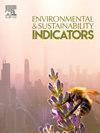Resilience capacity among the vulnerable farming households in Meki River catchment, Central Rift Valley of Ethiopia: Present situation and future prospects
IF 5.4
Q1 ENVIRONMENTAL SCIENCES
引用次数: 0
Abstract
The concept of resilience has recently been measured from the food security perspective, to estimate the capacity to deal with the impacts of unpredictable shocks. This study indexed the resilience capacity of farming households and identified determining indicators of resilience across the three kebeles in Meki River catchment, Central Rift Valley of Ethiopia. The resilience measurement considered latent variables such as Climate Extremes, Access to Basic Services, Asset, Social Safety Nets, Stability, Adaptive Capacity, and Social Capital as resilience indicators. Principal component analysis and the Multiple Indicator Multiple Cause model were used to estimate the Resilience Capacity Index (RCI). The model showed that Asset, Stability, and Adaptive Capacity have a significant explanatory weight in estimating RCI. Adaptive Capacity was negatively correlated with the RCI while Asset and Stability showed a meaningful positive contribution to household resilience capacity. Besides, the model revealed that Stability significantly improved household Resilience Capacity (RC) across all the studied kebeles. In addition, among the selected households across the three kebeles, households in Dobena Gola and Dobena Enseno reported better RC to bounce back to the previous level of food security. In contrast, households in Sheliwasho were unable to resist shocks and stressors. Therefore, households possessing greater RC likely sustained their food security, whereas those with lower RC were more prone to experiencing food insecurity. Overall, the study reveals that RCI measurement should be validated across diverse geographical scales and climatic zones for accurate estimation of RC.

求助全文
约1分钟内获得全文
求助全文
来源期刊

Environmental and Sustainability Indicators
Environmental Science-Environmental Science (miscellaneous)
CiteScore
7.80
自引率
2.30%
发文量
49
审稿时长
57 days
 求助内容:
求助内容: 应助结果提醒方式:
应助结果提醒方式:


